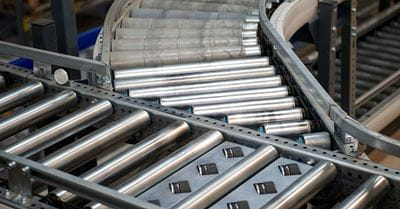Sortation Systems | Tucson

Raymond West supplies a full range of conveyor and automation products, including all types of sortation solutions.
To speak with an automation expert, phone us at (520) 729-4222.
Are you thinking about a sortation system for your Tucson warehouse, distribution center or production facility? The most popular kinds of sortation systems vary widely in capability and cost. In this article we offer a high level synopsis of the benefits and disadvantages of the three most common types of sortation systems.
Cross-Belt Sorter & Tilt Tray Sorter
Tilt-tray and cross-belt sorters provide similar functionality and are oftentimes lumped together when talking about sortation automation. However, they are very different mechanisms.
Tilt-tray sorters are a series of trays mounted to carts that are transferred on a continuous-loop conveyor. Items are added to the trays at one or more induction stations on the loop by means of manual or automated processes. When an item arrives at its sorting location, the tray that is transporting it tilts and dumps the product onto a chute.
Cross-belt sorters are powered belt conveyors mounted to carts operating on a continuous conveyor loop. Similar to tilt-trays, cross-belt sorters move products onto a chute when they reach the proper sorting location.
Advantages: Tilt-tray and Cross-belt sorters offer the highest sorting performance and can manage a wide variety of product types when compared to other sortation systems. They are a terrific choice for operations that handle a variety of SKUs. These types of systems are also reasonably noiseless and allow a more comfortable workplace for warehouse workers.
Disadvantages: The speed, capability and versatility or these sorters come at a price-- they are among the most costly sortation solutions offered.
Shoe Sorter
Sliding shoe sorters use a "shoe" system attached to the conveyor surface that nudges and diverts materials onto a secondary, after-sort conveyor. Shoe sorter solutions receive goods from a unified stream of items that may be a consolidated feed from multiple upstream areas of a facility. These types of sortation systems are widely used in shipping applications.
Advantages: Sliding shoe sorter equipment setups can accommodate a fairly high peak rate, often several hundred items per minute, depending upon the product weight and dimensions. In addition, a wide range of items can be processed due to the simplicity and flexibility of a positive divert system.
Disadvantages: Shoe sorters are more costly than other alternatives like pop-up wheel sorters. In addition, divert areas are not readily movable, making the system complicated and expensive to reconfigure. These systems also produce more noise than belt or tray solutions and are accordingly not as worker-friendly as other types of sorters.
Pop-up Wheel Sorter
Pop-up wheel sorters are an attractive option because they are fairly affordable and simple to deploy. Wheels or rollers are incorporated into a belt conveyor. When a product must be diverted, the wheels momentarily raise to move items at an angle to a secondary, downstream conveyor.
Advantages: Pop-up wheel sorters are adaptive, so components can be quickly incorporated or taken away when the line needs reconfiguration. These systems can likewise be substantially less expensive than other sorter options.
Disadvantages: These kinds of sorters provide far less speed and capability than shoe, cross-belt or tilt-tray options. They will undoubtedly enhance performance, but might not maximize total output like other alternatives. Since pop-up systems do not offer a positive divert, the types of items they can manage are reduced.
Automated Sortation Systems Near Me
To get more guidance on sortation options, get in touch with an automation professional at Raymond West Inc today!
Raymond West Inc
Tucson Service Area:
Tucson, Oro Valley, Marana, Sahuarita, South Tucson, Green Valley
(520) 729-4222

